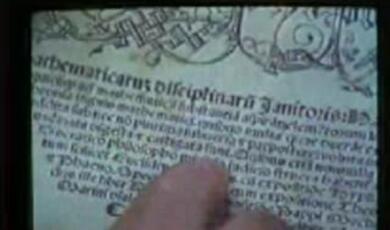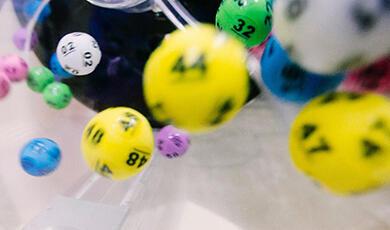Keep taking the tablets
Share
- Details
- Text
- Audio
- Downloads
- Extra Reading
Many thousands of surviving mathematical clay tablets provide much information about Mesopotamian mathematics - but what mathematics did they do, and why is it relevant to us today? In contrast, although the Egyptian pyramids provide us with an impressive primary source, only a handful of mathematical papyri survive. What do they contain, and what influence did they have?
Download Text
KEEP TAKING THE TABLETS
Professor Robin Wilson
Introduction
Before encouraging you to take the tablets, I’d like to say what a great honour and privilege it is to have been awarded the Gresham Chair of Geometry – the oldest mathematical Chair in the country. It is also very humbling, when one considers that my predecessors include Henry Briggs (the co-inventor of logarithms), Isaac Barrow (who worked with Isaac Newton in Cambridge ), and Robert Hooke (inventor of the microscope and first curator of experiments for the Royal Society). In those days, the appointment was for life as long as they remained unmarried, they were expected to live in Gresham College, and they were required to present their lectures in both English and Latin.
A later holder of the Chair was the distinguished statistician Karl Pearson, who in a Gresham lecture introduced the term ‘standard deviation’ for the first time. Recent Gresham professors have included such well-known communicators as Ian Stewart, Sir Christopher Zeeman and Sir Roger Penrose. Fortunately, the rules have now changed – I don’t have to live here, I can remain married, I’m not required to give this lecture in Latin, and my appointment is for just three years.
This last change means that the holders can concentrate on their own special interests without feeling that they have to cover the whole field of mathematics. Thus, my immediate predecessor Harold Thimbleby told you a lot about computers, his predecessor Sir Roger Penrose concentrated on topics related to mathematical physics, while his predecessor Ian Stewart covered a wide range of applications of mathematics to many other fields.
For myself, I shall concentrate on What mathematics is, and where it has come from. After Christmas I’ll describe two of the so-called ‘millennium problems’, each of which will earn you a million dollars if you can solve it. For the autumn lectures I’ll attempt to cover the entire history of mathematics in nine lectures, as I’ve outlined here, starting with the multi-cultural origins of the subject – from Egypt and Mesopotamia, from Greece, and from China, India and the Mayan Empire, before moving on to the Islamic world and Europe in the Middle Ages. These periods are shown on this time-line, covering my first four history lectures.
The history of mathematics
But before transporting you to Egypt and Mesopotamia, we might ask:Why do we need to study the history of mathematics? It seems to me that there are a number of reasons.
First of all, mathematics is part of our heritage – as central as literature and painting – and we need to study a culture’s mathematical artefacts for the same reasons as we study its cave paintings, its buildings or its literature: indeed, it’s been claimed that mathematics is one of the two oldest professions in the world, and so we certainly need to investigate its origins. Secondly, mathematics is not just the tidied-up God-given subject that we find in our textbooks. On the contrary, it reveals itself as a fundamentally human endeavour – whether we’re interested in the counting of sheep, the collection of taxes, or the measurement of time. On the other hand, if we’re primarily interested in the mathematics itself, then our understanding may be significantly increased if we can explore the context from which it developed – whether as a practical problem arising in technology or astronomy or the biological sciences, or whether it arose out of a desire to solve a mathematical puzzle or develop a mathematical idea. And finally, going back to the original sources can provide new motivation – our reasons for studying a subject now may differ markedly from the original purpose in studying a problem. Perhaps bored schoolchildren would find quadratic equations more fun if they’re told that the methods originated in Iraq some four thousand years ago, and if they’re encouraged to decipher the solution themselves by studying the markings on a clay tablet. As the nineteenth-century Norwegian mathematician Abel exclaimed: ‘Read the Masters!’
Ancient Egypt
Today we start our story with Egypt and Mesopotamia. Ancient Egypt developed along the valley of the Nile, while Mesopotamia (as its name suggests) developed between two rivers, the Tigris and the Euphrates. As we’ll see, the surviving primary sources are markedly different. We know relatively little about the Egyptian world, because their writings were on papyrus which rarely survives the ravages of the centuries – only a handful of mathematical papyruses still exist. On the other hand, Mesopotamian mathematics was imprinted on clay tablets that were baked in the sun, and many thousands of them have come down to us. Incidentally, what I call ‘Mesopotamian mathematics’ is often called ‘Babylonian mathematics’ – but that term is now going out of use since we know of no mathematical tablets from Babylon itself.
When studying the mathematics of ancient Egypt, we’re immediately struck with how little the subject changed over a period of 3000 years. Egyptian society was centred in the valley of the River Nile, which irrigated the land so that crops could grow and cities could develop. The civilisation was a hierarchical one headed by the mighty kings and pharaohs.
From about 2700 BC the pharaohs desired to be buried in massive pyramids. The oldest of these, King Djoser’s step pyramid at Saqqara, was constructed in horizontal layers and was supposedly designed by Imhotep the celebrated court physician, Grand Vizier and architect.
Better known are the magnificent pyramids of Giza, which date from about 2600 BC and attest to the Egyptians’ extremely accurate measuring skills. In particular, the Great Pyramid of Cheops has a square base whose sides of length 230 metres agree to less than 0.01%. Constructed from over two million blocks, averaging around two tonnes in weight and transported fifty miles by a whole army of workers, the pyramid is an impressive 146 metres high. Even more remarkable, it’s not solid, but contains an intricate arrangement of carefully planned internal chambers and passageways.
Our knowledge of later Egyptian mathematics is scanty, deriving mainly from a small number of fragile primary sources – notably, the Moscow papyrus (c. 1850 BC) and the Rhind papyrus (c. 1650 BC) which is in the British museum. Here’s part of the latter, showing some geometrical problems, with one of them blown up so that you can see the detail. Such problems were used in the training of scribes – here we see an Egyptian scribe. As you’ll see, although some of the problems are superficially practical in nature, their main purpose seems to have been educational.
But before we work through some Egyptian problems in detail, let’s first look at their counting system. Like most counting systems it was based on ten, but it used different symbols for one, ten, a hundred, a thousand, and so on – here they are: a vertical rod for 1, a heel bone for 10, a coiled rope for 100, a lotus flower for 1000, and so on – recall that Roman numerals similarly use different symbols for 1, 10, 100 and 1000. A number is then represented with the appropriate number of each symbol, written from right to left. Here are the representations of 367 and 756 – and we can add them together by collecting the symbols together and replacing each group of ten by the next symbol – for example, ten rods give a heel bone, and ten coiled ropes give a lotus flower.
Multiplication is more interesting, and was done mainly by successivedoubling and halving – though multiplication by ten was also simple, since they just replaced each symbol by the next one. In their calculation of 80 times 14, taken from the Rhind papyrus Problem 69, we write 80, and then replace each rod by a heel bone to get 800. We next return to our 80 and double it to get 160, and then 320. If we now add the rows corresponding to 10 and 4, we get the answer, 1120.
A more complicated problem is number 25 on the Rhind papyrus. A quantity and its half added together become 16. What is the quantity? In modern algebraic terminology, which they didn’t use, we’d be trying to solve the equation x + ½x = 16.
The method that they frequently used was the method of false position, in which they guessed a convenient solution and then scaled it up or down. Here, it’s convenient to try 2, so that the quantity and its half is 3. We now need to scale the 3 up to 16, and the same scaling applied to 2 will then give the answer. Again, doubling is used, as is multiplication by 2/3. The appropriate rows are then singled out, and we obtain the answer, 10 2/3. Finally, under the heading of ‘Do it thus’, this solution is checked.
This mention of 2/3 leads us to Egyptian fractions, which are very different from those that we use. Apart from 2/3, all their fractions wereunit fractions, or reciprocals 1/ n. So, for example, where we’d write 2/ 11 they’d write 1/ 6 1/ 66, and where we’d write 2/ 13 they’d write 1/ 8 1/ 52 1/ 104. Their ability to calculate with these unit fractions can be seen from Problem 31 of the Rhind papyrus. A quantity, its 2/3, its ½, and its 1/ 7, added together become 33. What is the quantity? In our algebraic notation, this problem requires us to solve the equation x + 2/3x + ½x + 1/ 7x = 33. Their answer, which we’d write as 14 28/ 97, is 14 ¼ 1/ 56 1/ 97 1/ 194 1/ 388 1/ 679 1/ 776 – an impressive feat of calculation.
How did they do it? They used extensive tables of numbers, breaking the fraction down to a succession of fractions of the form 2/ n, and then combining these repeatedly. To this end, the Rhind papyrus starts with a table of fractions of the form 2/ n, for all odd numbers n from 5 up to 101.
A rather different type of problem involves the area of a circle. Problem 48 asked the scribe to compare the areas of a circle and its circumscribing square. Choosing the diameter of the circle and the side of the square to be 9, the area of the square was obtained by comparing 1 with 9 setat (the unit of measurement), 2 with 18 setat, 4 with 36 setat, and 8 with 72 setat, and then adding the rows corresponding to 1 and 8 (which add to 9) to yield 81 setat. For the circle, the papyrus starts by comparing 1 with 8 setat and proceeding as before, giving an answer of 64 setat.
The reason for starting with 8 for the circle is that the Egyptians found the area of a circle to be close to that of an octagon inscribed in the square: if the side of the square is d, then the approximation they used for the area is (d – d/ 9) 2 = 8/ 9d 2 – this is why they chose an initial diameter of 9. In terms of the radius the area is 256/ 81r 2, which corresponds to a value of π of about 3.16, an excellent approximation for almost 4000 years ago.
Our last Egyptian problem from the Rhind papyrus is Problem 79: it involves adding powers of 7. The papyrus lists Houses 7, Cats 49, Rice 343, Wheat 2401 and Hekat 16807, and then proceeds to add them all up (for no apparent reason) to give 19607. A similar problem appears in Fibonacci’s Liber Abaci of 1202: 7 old women are going to Rome ; each has 7 mules; each mule carries 7 sacks; each sack contains 7 loaves; each loaf has 7 knives; each knife has 7 sheaths; what is the total number of things?
These problems are reminiscent of the nursery rhyme: As I was going to St Ives I met a man with 7 wives …, which ends Kits, cats, sacks and wives, How many were going to St Ives? The only difference is the twist in the tail – none of them was going to St Ives. But these examples dramatically illustrate the fact that the same mathematical idea can resurface in different guises over thousands of years.
Mesopotamian mathematics
Let’s now turn our attention to Mesopotamian mathematics. Although dating from the same time as the Rhind papyrus, the tablets we’ll look at are very different in content. Using a wedge-shaped stylus, the symbols were imprinted in the moist clay – this is called cuneiformwriting – and the tablet was then left to dry in the sun. Unlike the Egyptian counting system, a decimal system with different symbols representing the powers of 10, the Mesopotamian system was a place-value sexagesimal system (that is, based on 60) that used only two symbols – remnants of it survive in our measurement of time (60 seconds in a minute, 60 minutes in an hour) and of angle. However, there were ambiguities: the same succession of symbols may refer to any of 60 + 2, or 60 2 + (2 × 60), or 1 + 2/ 60, depending on the context.
To see how the sexagesimal system works, we consider a tablet from Larsa. The second and fourth columns don’t change as we move down the table, but how about the third column? We have the numbers 49, 50, 51…, increasing to 59, and then not 1 but 60. In the first column we interpret the first number not as 41 but as four 60s plus 1, which is 2401. Then we have forty-one 60s plus 40, which is 2500. The last number in the column is not 1 or 60, but 3600. Thus the table, when properly interpreted, gives a list of perfect squares, from 49 2 up to 60 2.
There are essentially two types of mathematical tablet – table texts, listing tables of numbers that are used in calculations, and problem texts, in which problems are posed and solved. Several table texts present multiplication tables, such as the nine-times table and the five-times table.
An example of a problem from a problem text is this one. I found a stone, but did not weigh it; after I weighed out 6 times its weight, added 2 gin (a unit of weight), and added one-third of one-seventh multiplied by 24, I weighed it: 1 ma-na (another unit of weight). What was the weight of the stone? This problem is clearly not a practical one – if we want the weight of the stone, why don’t we just weigh it? It is just one of 23 such problems, all on the same tablet and all ending up with 1 ma-na, which leads us to believe that the tablet is a teaching tablet. Given that 1 ma-na equals 60 gin, we argue as follows, using modern algebraic notation:
if x is the weight of the stone, then
(6x + 2) + 1/ 3 . 1/ 7 . 24 (6x + 2) = 60 gin, so x = 4 1/ 3 gin.
Note that we take one-third of one-seventh times 24 not of x, but of 6x + 2, the stage we’ve just reached in the calculation.
The next problem text is more complicated. I have subtracted the side of my square from the area: 14,30. You write down 1, the coefficient. You break off half of 1. 0;30 and 0;30 you multiply. You add 0;15 to 14,30. Result 14,30;15. This is the square of 29;30. You add 0;30, which you multiplied, to 29;30. Result: 30, the side of the square. Again, this is not a practical problem – we cannot subtract the side of a square from the area. Putting it into modern algebraic notation, we have x 2 – x = 870, and the sequence of steps gives us successively: 1, ½, (½) 2 = ¼, 870¼, 29½, 30. It turns out that if we carry out the same operations on the general equation x 2 – bx = c, we get the same result as we’d get nowadays from the quadratic equation formula. Thus, the Mesopotamians knew how to solve quadratic equations 4000 years ago, using essentially the same method that we use today.
A particularly unusual tablet shows a square with its two diagonals, and the numbers 30, 1;24,51,10 and 42;25,35. It turns out that these refer to the side of the square (30), the square root of 2, and the length of the diagonal (30√2). The amazing accuracy of the square root 1:24,51,10 becomes apparent if we square it – we get 1; 59,59,59,38,1,40, which differs from 2 by a minute fraction.
Of great importance to Mesopotamian mathematicians were reciprocals of numbers, since by using them one could both multiply and divide. A table text of reciprocals gives the reciprocals of all the numbers that can be made up from 2, 3 and 5, since these are the only ones with finite expressions. For example, the reciprocal of 9 is 0;06 40, since 9 times 0;06 40 is 1 (or, equivalently, 9 times 6 2/ 3 is 60).
Reciprocals appear in the problem of the igum and the igibum. The igibum exceeds the igum by 7. What are the igum and the igibum? This problem seeks a pair of reciprocals – or, equivalently, two numbers differing by 7 whose product is 60. In modern terms, we may express this as the problem of finding two numbers x and y for which x – y = 7 and xy = 60. This is a quadratic problem, which can be solved much as before, and the answer is: igibum = 12, igum = 5. It can also be solved geometrically, using the idea of completing the square.
Our final clay tablet is the table text known as Plimpton 322, after its catalogue number in Columbia University library in New York. It consists of fifteen lines in four columns. The final column numbers the lines 1 to 15, while columns 2 and 3 give the shortest side (B) and the longest side (C) of various right-angled triangles. The first column, which has become damaged and in which the numbers appear in decreasing order, gives the number C 2 / C 2 – B 2, or 1 more than this quantity.
This tablet has been interpreted in various ways. Some people claim that it is a trigonometrical table derived from a right-angled triangle, asserting that the Mesopotamians ‘knew Pythagoras’s theorem’ and ignoring the fact that angles have appeared on no other contemporaneous tablets and were not studied for a further 1500 years. Others claim that the tablet is a table of Pythagorean triples a, b, c, where a = p 2 – q 2, b = 2pq, c = p 2 + q 2, and a 2 + b 2 = c 2. If this were the case, then the numbers pwould appear down the left-hand column in decreasing order, which they don’t. A third hypothesis, now widely accepted, is that the numbers in the columns are derived from reciprocals x and 1/x, and that the numbers appear in the ratios ½(x – 1/x), ½(x + 1/x) and 1. This hypothesis seems to fit the tablet mathematically, historically and linguistically, but there is still much debate on the matter.
In the next lecture we move forward over one thousand years and turn our attention to the Greeks, and to the world of Pythagoras, Plato, Aristotle, Euclid and Archimedes.
Robin Wilson, 6 October 2004
References
Otto Neugebauer, The Exact Sciences in Antiquity, Dover, 1969 (original edition, 1949).
MA 290, Topics in the History of Mathematics, Unit 1, Early mathematics, Open University, 1987.
John Fauvel and Jeremy Gray (eds.), History of Mathematics: a Reader, Macmillan, 1987.
Gay Robins and Charles Shute, The Rhind Mathematical Papyrus, British Museum Press, 1987.
Eleanor Robson, Words and pictures: new light on Plimpton 322,American Mathematical Monthly109 (2002), 105-120.
This event was on Wed, 06 Oct 2004
Support Gresham
Gresham College has offered an outstanding education to the public free of charge for over 400 years. Today, Gresham College plays an important role in fostering a love of learning and a greater understanding of ourselves and the world around us. Your donation will help to widen our reach and to broaden our audience, allowing more people to benefit from a high-quality education from some of the brightest minds.


 Login
Login







